This is the final post in the series that was published in 2016. After reading it again I realized that I have discovered a few things since it was first published.
We have grown some more plants that I have observed the honey bees foraging on heavily. They include chamomile which blooms in the spring and spearmint, peppermint and chocolate mint which all flower in late summer, so these can be added to the others you will read about in the original post.
The other thing that I recently read and thought would be worth including with this post is that honey bees will only forage one type of plant during a flight. Knowing this it stand to reason that they would be foraging a type of plant that is plentiful in the area. Thus if you are planting with honey bees in mind it would be better to plant several of one type of plant than to plant only one of several types of plants.
I hope you enjoy the original post.
Don't Eat It! Soap and Skin Care

Since we decided to become beekeepers I have read many recommendations about what to plant for the bees including the above picture. I feel very strongly that it is important for the health of the bees that they have a variety of foods (plants) to forage. Although it is not our only consideration when deciding what to plant, planting for the bees is something that we have been doing since we bought the farm and decided to become beekeepers.
Other things we take into consideration are:
1. Is the plant annual or perennial? Except for food and herbs we usually don’t plant annuals.
2. To know if a perennial will survive it is important to know the hardiness zone that you live in. Some plants that are perennial will not survive the colder temperatures of our winter and some will not even grow long enough to blossom.
3. It is also good to know the growing conditions that…
View original post 1,137 more words
My sister lives within a mile of me and has several hives. I always enjoy seeing her bees, at least I think they could be her bees, foraging on my plants.
LikeLiked by 1 person
When I see honey bees foraging on our farm I tend to think they are our bees but that is not necessarily so. There is at least one other beekeeper not far from us and there are likely wild honey bees in the area as well.
I always pay attention to what they are foraging and determine if I should grow more of it.
LikeLiked by 1 person
Bees are one of the things we want to add to our homestead in the next year or two. We’ve been focusing a lot our efforts this year on growing our food garden, but I’ve always loved to grow flowers as well.
I have a lot of daffodils, lilies and irises that we’re given to us last year from Gaby’s aunt who was digging out one of her flower beds. With no where to put them all, I lined the at the back end of our property, knowing that I’d eventually be moving them. This fall, I’ll be transplanting all of those flowers to the front of our property, closer to our vegetable garden. We believe that this will be beneficial to both us and our future bees, as there will be a lot to pollinate, and they’ll be pollinating our gardens while we’re at it.
Thanks for all the tips for various flowers, I’m getting excited about expanding what I’m calling my pollinator garden. I’ll definitely be adding in echinacea (I love how they look!) as well as some various cover crops.
LikeLiked by 1 person
I am not sure why but honey bees don’t seem to be attracted to daffodils, irises or lilies. I have all three planted as well. They do attract other pollinators though. I don’t know why I didn’t include garden vegetable in my posts but squash/pumpkins are the one garden plant that they forage the most besides that they really seem to like the herbs.
Bee keeping can be expensive and frustrating. Many bee keepers in our area lost lots of their bees this past winter and are starting over. We met someone on Friday that has come up with a new hive design that provides more ventilation in hopes that it will better support the bees through a hard winter. Our one hive that did survive this winter was a Warre’ hive. https://thebeespace.net/warre-hive/ This website explains Warre’ bee keeping and even has plans for building that type of hive for those that are skilled at wood working.
LikeLiked by 1 person
Good to know about those flowers! I won’t get rid of them (since they were free) but I will make sure to plant lots of other pollinators to attract them. Thanks for the tips!
LikeLiked by 1 person
Your welcome. Here is another tip. Deer like to eat lilies – I took many of mine and brought them to our house because every time they would get a flower the deer would come along and eat it. LOL
LikeLiked by 1 person
Lol. So far they’ve been safe from deer, but I’ve had problems in the past with the red lily beetle. So frustrating!
LikeLiked by 1 person
Interesting to see that they forage one type of plant during flight.
I think I was aware of the chamomile being attractive to them, but not really the spearmint, etc.
LikeLiked by 1 person
Although I’ve only observed bees foraging one type of plant at a time (dandelion to dandelion or clover to clover) I never realized this until I read it.
They were heavily foraging mints last fall when there was little else available for them.
LikeLiked by 1 person